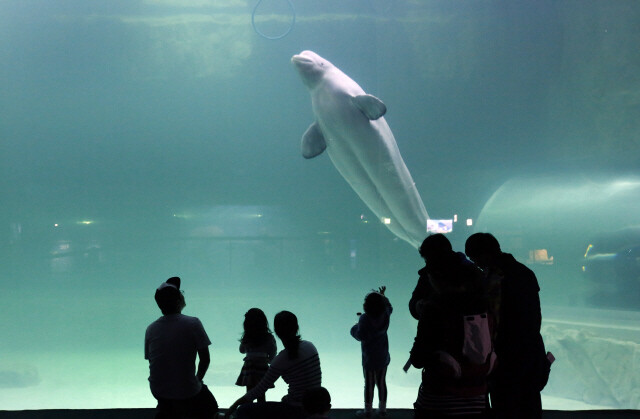hankyoreh
Links to other country sites 다른 나라 사이트 링크
After animal death, Lotteworld says it won’t acquire more beluga whales

Lotteworld Aquarium has announced that it will stop acquiring beluga whales. Since this means that the aquarium will bring a natural end to its practice of raising and displaying dolphins in captivity, it raises the question of whether this will prompt similar action from other aquariums or zoos confronted with negative public opinion.
“We will not be purchasing any more cetaceans,” Lotteworld Aquarium said on Apr. 18. “We will stop researching ways to breed them in captivity, and we will dedicate ourselves to creating an environment that will reinforce animal welfare.”
The decision was made in deliberation with the Korean Animal Welfare Association, and Lotteworld and the association issued a joint press release on Monday in which they promised to cooperate in the future.
Lotteworld Aquarium, which opened in 2015 as part of Lotte World Tower, a major project for the Lotte Group, is South Korea’s newest facility that exhibits marine mammals and fish.
The aquarium has advertised three beluga whales named Belli, Bella and Bellu that it acquired from Russia. The belugas are Arctic cetaceans, a rare sight in South Korea.
But on Apr. 2, Bellu died of septic shock, and the aquarium was caught up in a storm of accusations about animal abuse. The aquarium‘s announcement implies that Belli and Bella will be displayed in the aquarium for the rest of their lives.
Belli, Bella and Bellu were captured at a young age in the Sea of Okhotsk, off the coast of Russia, and were raised at a dolphinarium called the Tinro Center near Vladivostok, a city in Russia’s far east.
According to materials provided by the International Union for Conservation of Nature (IUCN), the Tinro Center captures between 20 and 30 wild belugas each year and supplies them to aquariums around the world. The center is on the watch list of international environmental organizations, along with Taiji, Japan, which is infamous as a site of dolphin slaughter.
The Tinro Center sold Belli and the other two belugas to South Korea in May 2013. At the time of their arrival in the country, Belli was six years old, while Bella and Bellu were two years old.
“Considering the fact that Belli and Bella were captured in Russia at a young age, we need to deliberate with domestic and foreign experts about the possibility of releasing them into the wild,” the Korean Animal Welfare Association said on Monday.
When released into the wild, dolphins must be returned to their original habitat. Furthermore, the more experience they have living in the wild, the greater their chance of success.
An Indo-Pacific bottlenose dolphin named Jedori who was successfully returned to the waters around Jeju lived more than seven years in the wild.
“There is no record on the official import papers of when the belugas were captured in the wild,” said Jeong Ji-yun, the director of the exhibition team at Lotteworld Aquarium, on Apr. 18.
This decision by Lotteworld Aquarium is thought to follow the announcement on Mar. 17 by the largest dolphin displaying company in the world - SeaWorld in the US - that it will stop holding performances by killer whales and stop breeding them in captivity.
While the dolphin exhibition and performance industry has already gained a stigma as a “bad industry” in Europe and vanished from the UK in the 1990s, it has recently been gaining ground in China and South Korea.
Currently, 41 dolphins are being raised at eight aquariums in South Korea, including those at Seoul Grand Park and Hanwha Aqua Planet.
By Nam Jong-young, staff reporter
Please direct questions or comments to [english@hani.co.kr]

Editorial・opinion
![[Editorial] Does Yoon think the Korean public is wrong? [Editorial] Does Yoon think the Korean public is wrong?](https://flexible.img.hani.co.kr/flexible/normal/500/300/imgdb/original/2024/0417/8517133419684774.jpg) [Editorial] Does Yoon think the Korean public is wrong?
[Editorial] Does Yoon think the Korean public is wrong?![[Editorial] As it bolsters its alliance with US, Japan must be accountable for past [Editorial] As it bolsters its alliance with US, Japan must be accountable for past](https://flexible.img.hani.co.kr/flexible/normal/500/300/imgdb/original/2024/0417/6817133413968321.jpg) [Editorial] As it bolsters its alliance with US, Japan must be accountable for past
[Editorial] As it bolsters its alliance with US, Japan must be accountable for past- [Guest essay] Amending the Constitution is Yoon’s key to leaving office in public’s good graces
- [Editorial] 10 years on, lessons of Sewol tragedy must never be forgotten
- [Column] A death blow to Korea’s prosecutor politics
- [Correspondent’s column] The US and the end of Japanese pacifism
- [Guest essay] How Korea turned its trainee doctors into monsters
- [Guest essay] As someone who helped forge Seoul-Moscow ties, their status today troubles me
- [Editorial] Koreans sent a loud and clear message to Yoon
- [Column] In Korea’s midterm elections, it’s time for accountability
Most viewed articles
- 1[Column] The clock is ticking for Korea’s first lady
- 2[News analysis] After elections, prosecutorial reform will likely make legislative agenda
- 3Samsung barricades office as unionized workers strike for better conditions
- 4[Editorial] Does Yoon think the Korean public is wrong?
- 5‘Right direction’: After judgment day from voters, Yoon shrugs off calls for change
- 6Korea, Japan jointly vow response to FX volatility as currencies tumble
- 7[Editorial] When the choice is kids or career, Korea will never overcome birth rate woes
- 8Why Israel isn’t hitting Iran with immediate retaliation
- 9S. Korea, Japan reaffirm commitment to strengthening trilateral ties with US
- 10Japan officially says compensation of Korean forced laborers isn’t its responsibility